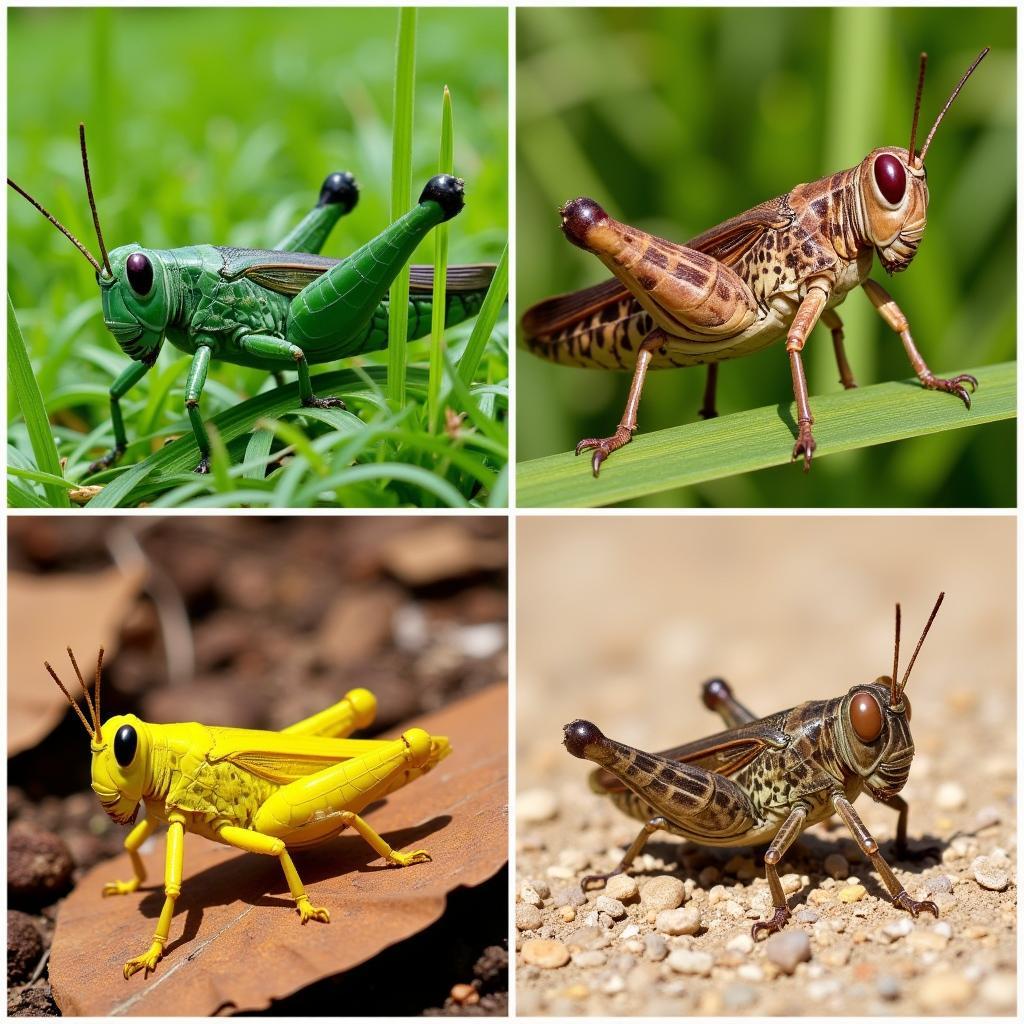Grasshoppers, those ubiquitous insects of fields and meadows, are often associated with a vibrant green hue. But are all grasshoppers green? The answer, as you’ll soon discover, is more nuanced than you might think. The color of a grasshopper can vary greatly depending on a variety of factors, from species and environment to individual genetics and even their life stage.
The Colorful World of Grasshoppers: Beyond Green
While green is a common color for grasshoppers, these fascinating creatures can sport a surprising range of colors, including browns, yellows, reds, and even pinks. This diversity stems from several key factors that influence their pigmentation.
Camouflage and Survival
One of the primary reasons for the variation in grasshopper color is camouflage. Grasshoppers are a favorite food for many predators, including birds, reptiles, and amphibians. To survive, they have evolved to blend seamlessly into their surroundings. Grasshoppers living in grassy areas tend to be green, while those residing in drier, browner environments often exhibit earth-toned coloration. This adaptation allows them to effectively evade predators and increase their chances of survival.
Genetics and Individual Variation
Just like humans, grasshoppers possess unique genetic makeup that influences their physical characteristics, including color. Even within the same species, you might find individuals displaying subtle variations in shade or pattern. This genetic diversity contributes to the overall richness of the grasshopper population.
Life Stage and Molting
The color of a grasshopper can also change throughout its life cycle. As nymphs, they may exhibit different colors than their adult counterparts. Additionally, grasshoppers molt their exoskeletons multiple times as they grow. Each molt can bring about slight changes in their coloration, allowing them to better adapt to their changing environment.
 Grasshopper Color Variations in Different Environments
Grasshopper Color Variations in Different Environments
Environmental Factors and Color Change
In some cases, grasshoppers can even change color during their lifetime in response to environmental factors such as temperature, humidity, and light exposure. This remarkable ability allows them to fine-tune their camouflage and maintain their advantage in the face of changing conditions.
What Color is a Young Grasshopper?
Young grasshoppers, known as nymphs, often exhibit colors different from adults. They may start out with lighter or brighter hues and gradually develop their adult coloration as they mature. This color change can also be influenced by the environment and food sources available to them.
The Most Common Grasshopper Colors
While grasshoppers can come in a rainbow of colors, green and brown are undoubtedly the most frequently encountered. These colors provide excellent camouflage in the most common grasshopper habitats – grasslands and fields.
Green Grasshoppers: Masters of the Meadow
Green grasshoppers blend seamlessly into lush green vegetation, making them practically invisible to predators. This coloration is particularly effective in meadows, pastures, and other grassy areas.
Brown Grasshoppers: Blending into the Background
Brown grasshoppers, on the other hand, thrive in drier environments with more exposed soil and vegetation. Their earth-toned hues allow them to disappear amongst dried leaves, branches, and the ground itself.
Why are Grasshoppers Important?
Grasshoppers play a significant role in the ecosystem. They serve as a food source for many animals and contribute to nutrient cycling by consuming plants and breaking down organic matter. Their presence is an indicator of a healthy ecosystem.
Conclusion
So, What Color Are Grasshoppers? They can be a surprisingly diverse array of colors, primarily determined by the need for camouflage, genetics, and their life stage. While green and brown are the most common, don’t be surprised to encounter grasshoppers in other hues as you explore the natural world. Their fascinating adaptability and color variations make them a truly captivating insect.
FAQs
- Can grasshoppers change color? Yes, some grasshoppers can change color during their lifetime due to environmental factors.
- What is the most common grasshopper color? Green and brown are the most common grasshopper colors.
- Why are grasshoppers green or brown? These colors provide excellent camouflage in their typical habitats.
- What do young grasshoppers look like? Young grasshoppers, or nymphs, can have different colors than adults and gradually develop their adult coloration.
- Are all grasshoppers green? No, grasshoppers can come in a variety of colors, including brown, yellow, and even pink.
- What do grasshoppers eat? Grasshoppers primarily feed on plants.
- What eats grasshoppers? Birds, reptiles, amphibians, and other insects prey on grasshoppers.
Do praying mantises change color? Find out more here.
Curious about what gardening zone Denver, Colorado is in? Learn about it here.
Need help with your next painting project? Contact Color Box Hanoi at 0373298888 or [email protected]. Visit us at 86 Cau Giay, Hanoi. We’re available 24/7 to assist you.
